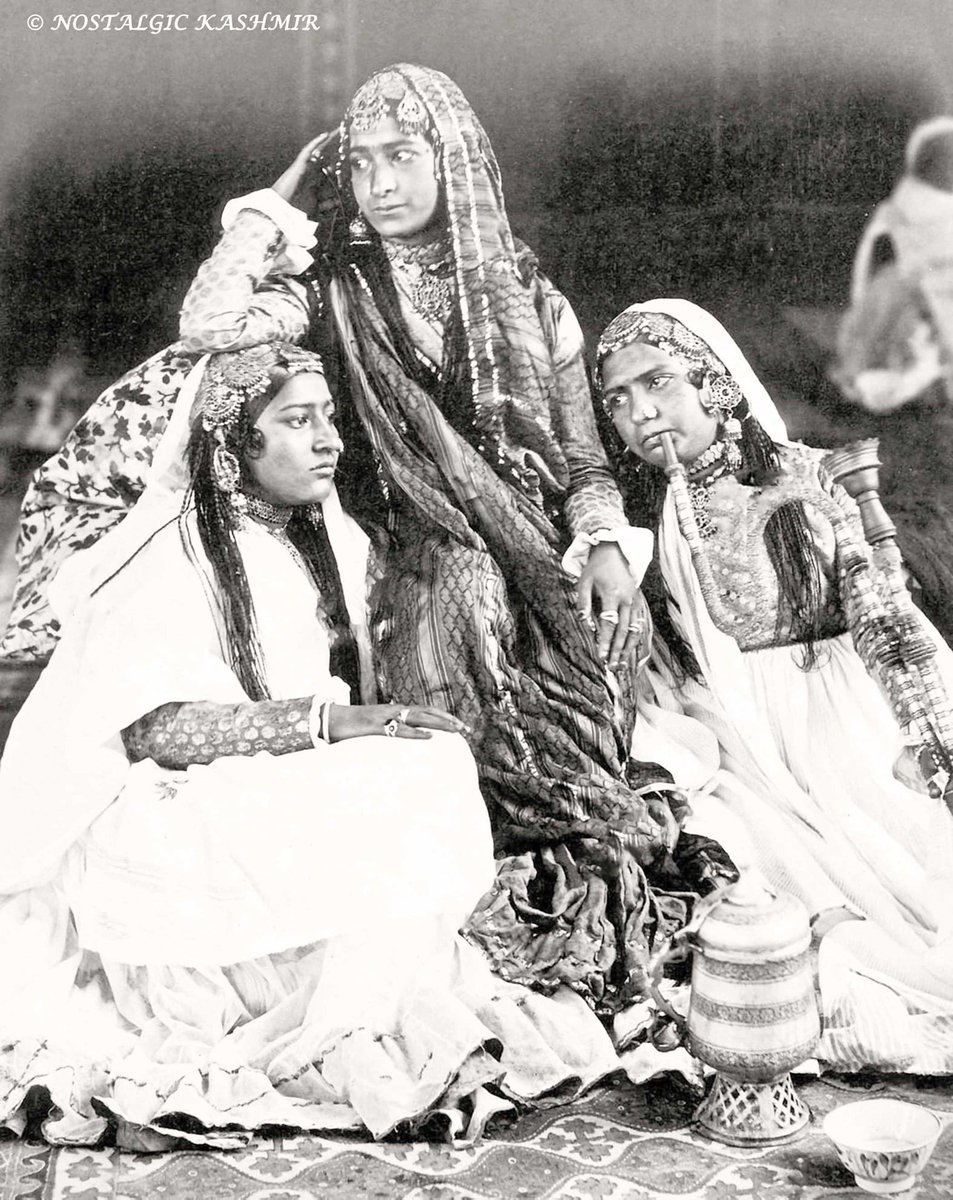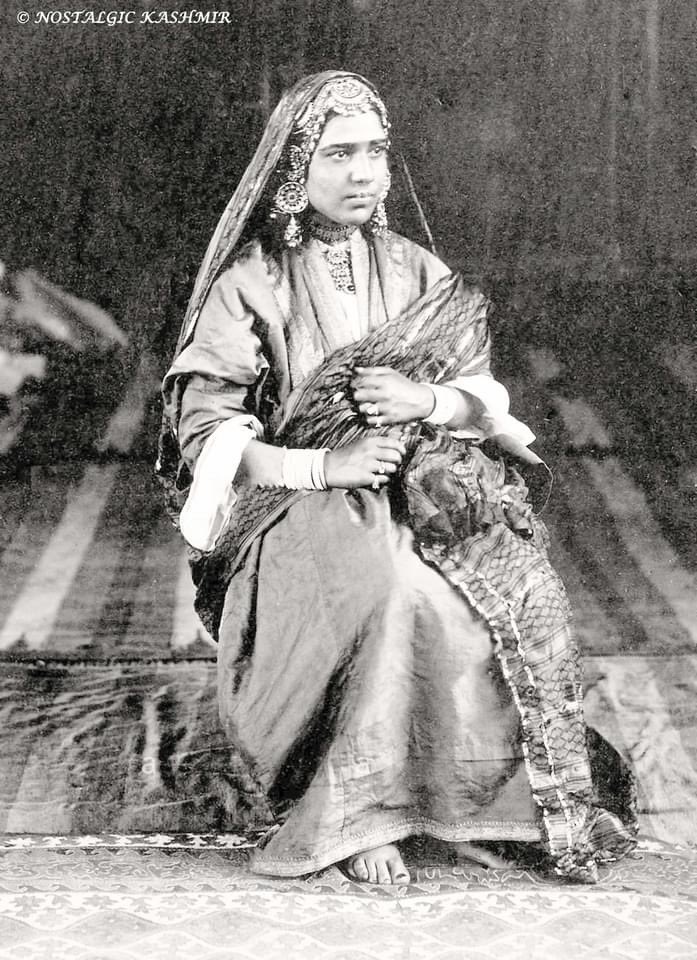
PROSTITUTION IN KASHMIR
(Graphic post)
Kalhana has censured some of the kings like Kalasha, Kshemagupta, Uccala and Marsha for patronizing prostitutes, paramours and courtesans. It was Sultan Sikander who is reported to have banned prostitution in his sultanate. (1/n)
(Graphic post)
Kalhana has censured some of the kings like Kalasha, Kshemagupta, Uccala and Marsha for patronizing prostitutes, paramours and courtesans. It was Sultan Sikander who is reported to have banned prostitution in his sultanate. (1/n)
Afghan period in Kashmir which started in 1753 was the worst period in this regard, when the Kashmiri slaves, both women and men were exported to Kabul. Amir Khan Jawan Sher The Afghan Governor institutionalized the trade and all those involved were registered. (2/n)
The sale of young Muslim girls in Kashmir to established houses of ill-fame was both protected and encouraged during Dogra rule, as it was highly beneficial to the exchequer in form of taxes. (3/n) 

These girls were basically dancers but with passage of time and heavy taxes of the authorities they leaned towards prostitution also. They were given the decent title of ‘Hafiza’. (4/n)
All Hafizas had to pay a hefty registration fee of 200 chikle rupees per year PLUS half of their total earnings which amounted to almost 15% to 25% of the total yearly revenue of the state. State required money because it had paid British a sum of 75 lakh Rupees in sale deed.5/n 

The Dogra Maharajas not only supported but encouraged the institution of prostitution at Governmental level, as it brought then the much sought over money in the form of Kanjur tax. (6/n) 

In Srinagar city, the red light area of Maisuma, Gawakadal and Tashwan, were most prominent. In 1867, Arthur Brinkman, in his work - the Wrongs of Kashmir, indicted the government of the Maharaja, for patronizing prostitution in Kashmir. (7/n)
In 1868, Robert Thrope wrote that the Kashmiri girls were being forced into prostitution by the authorities with the idea of earning more and more revenue from licensing the flesh trade.
(8/n)
(8/n)

To legalize the institution of prostitution the Dogra Rulers had also sanctioned the Public Prostitutes Rules 1921. (9/n)
Mohammad Subhan Hajam was a barber by profession. He is a Kashmiri icon, a reformer, a social activist and a visionary who succeeded in mobilizing public opinion for eradication of prostitution in Kashmir and succeeded in his mission during his life time. (10/n)
Mohammad Subhan Hajam was terrorized and attacked several times by the pimps and goons employed by keepers of the prostitution dens. In order to suppress his voice, several false cases were instituted against him in the courts of Srinagar. (11/n) 

All these attacks on him were spearheaded by a rich and influential red light area chief known contemptuously as Khazir Gaan, his name being Khazir but Gaan or prostitution den holder. He would corrupt police officers to seek vengeance on Mohammad Subhan Hajam. (12/n)
It was Molvi Mohammad Abdullah Vakil, who raised the issue in the Praja Sabha in 1934 and proposed exacting of a law for the closure of prostitution houses in the State and ban on the flesh trade. (13/n)
The State Assembly passed " The Supression of Immoral Trafficking Act in 1934" . The assembly even ordered deputation of two Police officers to find and repatriate Kashmiri girls from the red light areas of Rawalpindi, Lahore, Peshawar, Quetta, Delhi and Lucknow. (14/n)
A police officer Abdul Karim recovered a large number of such unfortunate girls. Due to the herculean efforts of Mohd Subhan Hajam these is no red light area in Jammu & Kashmir. (n/n)
Graphic Images purely for historical significance and awareness:
Photograph taken by Samuel Bourne in 1864 of a prominent hafiza named Mirjan (P1)
Photograph taken by Samuel Bourne in 1864 of a prominent hafiza named Mirjan (P1)

Photograph taken by Samuel Bourne in 1864 of a prominent hafiza named Sabi. The variety of objects that were a part of their world are carefully presented. These include the Tea Samovar with cups and Hookah. (P2) 

Elaborately decorated brocade clothes with traditional jewelry of the time. Despite the Glamour and Trappings the life of these women was genuinely difficult.
Photograph taken by John Burke & William Baker in 1869 showing Hafizas resting after a performance. (P3) 

Photograph taken by John Burke & William Baker in 1869 of a prominent hafiza named Azee after performing in all her best finery. (P4) 

Photograph taken by Herford Tynes Cowling in 1926 of Nautch Girls of Jammu during the week long festivities related to Coronation Ceremony of HH Maharaja Hari SIngh in September 1926 at Mubarak Mandi Place Complex Jammu. (P5) 

Photograph taken by John Burke & William Baker in 1869 showing a hafiza performing at Shalimar Bagh. Many of these artists stayed and performed at Shalimar Bagh during the visits of Royal Guests in summers. (P6) 

THE HISTORY OF PROSTITUTION AND BEGAAR (Thread below) IN KASHMIR POINTS TO THE FACT THAT KASHMIRIS WERE EXPLOITED AS REVENUE GENERATING BEASTS. THOSE WHO COULD NOT WORK AS SHAWL AND CARPET WEAVERS WERE ‘USED’ AS ANIMALS, EITHER IN INHUMAN ‘BEGAAR’ OR VILIFIED IN PROSTITUTION.
• • •
Missing some Tweet in this thread? You can try to
force a refresh















